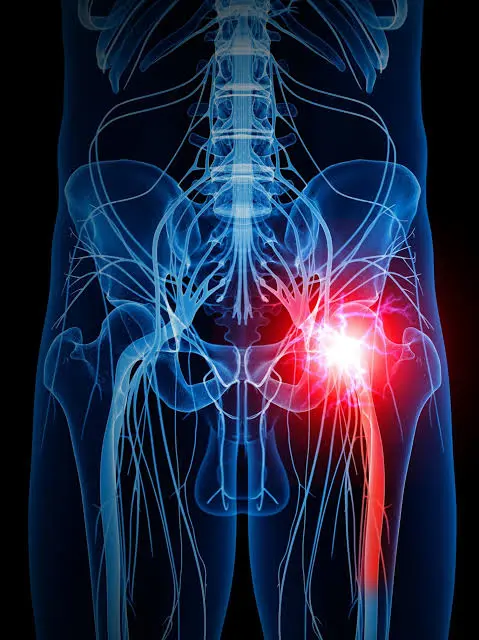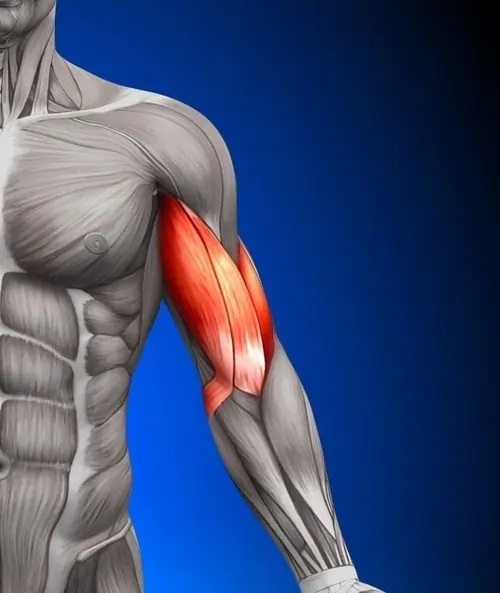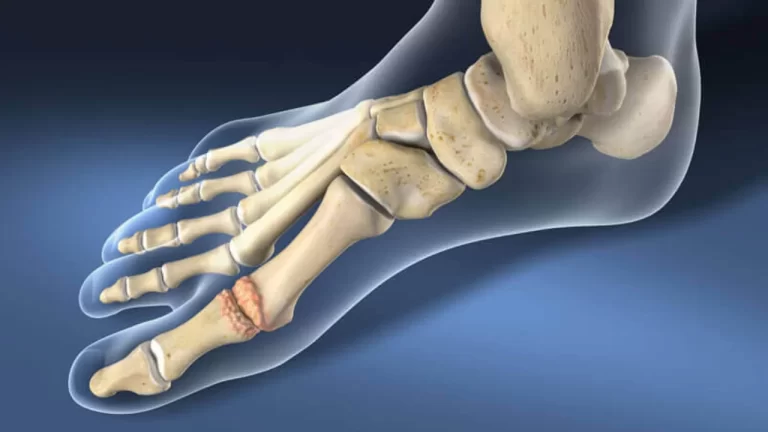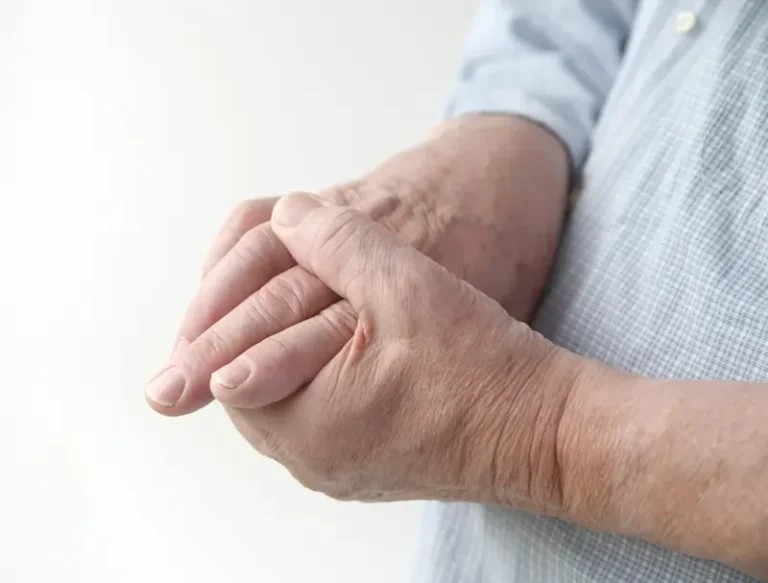Sciatica Nerve Pain Home Treatment
Table of Contents
Introduction
Sciatica is a type of nerve pain caused by irritation or damage to the sciatic nerve. It may also cause tingling or numbness in your butt or back, which may extend down your leg in addition to pain. It’s also possible for symptoms to get worse.
If you have sciatica, you can feel pain anywhere that the sciatic nerve is connected, ranging from mild to severe. Your legs, hips, buttocks, and lower back may be affected by the symptoms. Certain symptoms may reach your feet and toes, depending on which nerve or nerves are impacted.
While medical intervention may be necessary for severe cases, many individuals find relief from sciatic nerve pain through home treatments. These approaches aim to reduce inflammation, alleviate pain, and promote overall spinal health.
In this guide, we’ll explore various home treatments for sciatica, including lifestyle adjustments, exercises, and self-care practices that can contribute to managing and preventing sciatic nerve pain.
Anatomy of sciatic nerve
It’s the longest and thickest nerve. It has a width of up to 2 centimeters, which is comparable to the width of an American penny or a British pence coin. It is not a single nerve, despite its name. In actuality, it is a collection of nerves originating from five nerve roots that split off from your spinal cord.
There are 2 sciatic nerves in the body, one on each side. On one side, each sciatic nerve passes through your buttocks and hips. Those split into additional nerves that supply information to regions further down, such as your foot, toes, and lower leg.
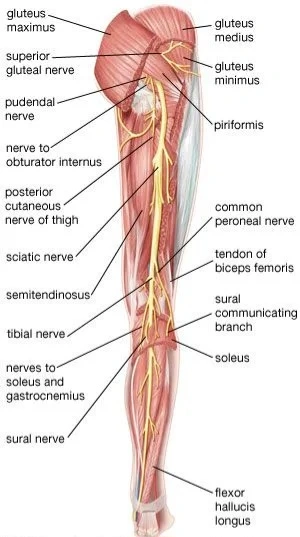
Origin
L4 to S3
Motor functions
It innervates the hamstring portion of the adductor magnus (the remaining portion is supplied by the obturator nerve) and the muscles of the posterior thigh, including the biceps femoris, semimembranosus, and semitendinosus.
Provides indirect innervation to all of the leg and foot’s muscles through its terminal branches.
Sensory functions
No direct sensory functions are present. Innervates the skin of the heel, dorsal, and plantar surfaces of the foot, and the lateral leg indirectly by its terminal branches.
Course
The lumbosacral plexus is the source of the sciatic nerve. Through the larger sciatic foramen, it exits the pelvis after forming and enters the gluteal region. It descends inferolaterally and emerges inferiorly to the piriformis muscle.
The posterior surfaces of the quadratus femoris, obturator internus, inferior gemellus, and superior gemellus muscles are crossed by the nerve as it passes through the gluteal region. It then passes deep to the long head of the biceps femoris before entering the posterior thigh.
The nerve originates in the posterior thigh and branches to the adductor magnus and hamstring muscles. The sciatic nerve finishes by splitting into the tibial and common fibular nerves at the tip of the popliteal fossa.
Branches
- Tibial nerve
- Common peroneal nerve
Causes
Any ailment that affects the sciatic nerve can cause sciatica. Conditions affecting any of the five spinal nerves that bundle to form the sciatic nerve may also cause it to occur.
- Disc herniation
- Deteriorating disc health.
- Spinal narrowing.
- Stenosis of the foraminal region.
- Pseudolisthesis.
- Arthritic bone.
- Accidents.
- Pregnancy.
- Growths such as cysts or tumours.
- Syndrome of the Conus Medullas.
- The cauda equine condition.
Types of sciatica
Two varieties of sciatica exist. Whichever type you have, the outcomes are the same. These kinds are:
Actual sciatica.
Any ailment or damage that directly affects your sciatic nerve falls under this category.
Conditions similar to sciatica.
These are disorders that resemble sciatica but have different causes that are connected to the sciatic nerve or the nerves that bundle into it.
Symptoms
Sciatica pain
The cause of sciatica pain is pressure on the nerve or nerves that are affected. The majority of people say that sciatica hurts like an electric shock or burn. Additionally, this pain frequently radiates or shoots down the affected leg. Coughing, sneezing, bending over, or raising your legs while lying on your back can all cause pain.
Paraesthesia, or “pins and needles,”
it’s tingling. This sensation is comparable to what you get when you sit cross-legged and one of your legs falls asleep.
Weakness of muscles
This symptom is more serious. It indicates that your back or legs are not receiving the muscle command signals that they should be receiving.
Urinary incontinence And Faecal incontinence
This symptom is extremely serious. It indicates that the signals governing your bowel and bladder aren’t getting where they should.
Diagnosis
Sciatica can be diagnosed by a medical professional using a variety of techniques. They’ll inquire about your symptoms and go over your medical history. They’ll perform a physical assessment as well. Those tests will consist of:
Your gait will frequently visibly alter as a result of sciatica. In order to diagnose sciatica, your physician will keep an eye out for such changes.
Test of straight leg raises. You will be asked to lie on an examination table with your legs extended. One by one, they will carefully move your legs towards the ceiling and inquire as to when you begin to experience any symptoms, including pain. These can assist in determining the origin of sciatica and its course of treatment.
Additional tests of strength and flexibility. These can assist your doctor in figuring out whether your sciatica is being caused by or is influenced by any other causes.
What examinations will be carried out to identify this illness?
Sciatica can be diagnosed and related disorders can be ruled out with the use of several tests. Among the most popular or likely tests are, but are not restricted to:
- computed tomography (CT) images or spine X-rays.
- scans using magnetic resonance imaging (MRI).
- Studies on nerve conduction velocity
- electrophysiology.
- myelography
Treatment of Sciatica pain
Medical Treatments
Sciatica pain may be lessened with the use of nonsteroidal anti-inflammatory drugs (NSAIDs), such as aspirin and ibuprofen. Pharmacy over-the-counter sales of these are available.
It Is important to remember, though, that these drugs are effective for sciatica. They have some potential side effects, just like any other medication. For instance, one typical adverse effect of some muscle relaxants is drowsiness.
Doctors may advise injecting steroids into the spine if the pain does not subside. Steroid injections reduce swelling, which helps with pain. This only temporarily relieves the pain, though, and for some people, it even exacerbates it.
Creams A few people report that using creams helps reduce the pain associated with sciatica.
Operative procedure
Most of the time, sciatica resolves on its own in a few weeks. Depending on what is causing the patient’s sciatica symptoms, if pain persists after approximately 12 weeks and conservative measures have not been effective, a surgeon may be recommended.
One type of surgery is the microdiscectomy. A microdiscectomy involves the removal of the damaged spinal disc segments that are putting pressure on the nerve by the surgeon. This procedure necessitates a brief hospital stay and is performed under general anaesthesia.
Although it’s rare, surgical treatments may result in more pain.
Physical Therapy
Plank
To execute a plank:
On the ground, lie face down.
Lift up onto the forearms and toes while maintaining a straight trunk and legs, being careful to keep the elbows exactly beneath the shoulders.
Hold it to the maximum limit
Mobilization of the sciatic nerve
How to mobilize the sciatic nerve:
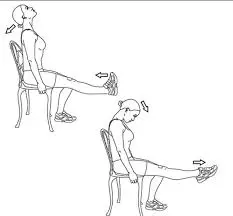
Place a small cushion under your head, bend your knees, and place your feet flat on the floor, hip-width apart, while lying on your back.
With both hands, grasp the back of one bent knee as it comes towards the chest.
Straighten the leg slowly. At the site of sciatic nerve pain, stop. Beyond this point, the pain might get worse.
Hold for ten to five seconds.
Trade places.
Ten to twenty repetitions on each side.
Home treatment and Stretches at home
Home treatment
Heat and cold
You can improve your function and reduce the pain associated with sciatica by applying heat or ice packs.
Use ice for the first seven days. Apply cold packs to your lower back to lessen sciatic nerve inflammation. Take care not to get frostbite on yourself. Icepacks should be wrapped in a cloth or towel to prevent skin contact. Give them a minimum of 15 to 20 minutes of rest in between each 15 to 20 minutes of leaving them in place. Try switching between on and off for a duration of 75 to 100 minutes. After that, pause to gauge your feelings.
An Ice massage is an additional method of applying cold to a sore spot. Chill the water in a paper cup, then rip off the upper portion of the container. Work the ice into the lower back in a circular motion. To avoid frostbite, cover an area with a diameter of roughly six inches and keep the cup moving. Steer clear of the spine’s bony region. Wait at least an hour between massages and limit your massage time to no more than ten minutes.
In between ice applications, you can try some light stretches, but it’s best to wait for the area to warm up for about thirty minutes. Applying three to five times a day could help reduce some of the discomfort.
After the first week, when some healing has occurred and the pain is lessening, heat can be applied. (If, after a week, the pain has not decreased at all, see a doctor.) Treatments with heat will improve blood flow to the area, hastening the healing process. Additionally, heat helps to relax the muscles, enabling mild stretching that may help to reduce pain.
You can take a warm bath, use a heating pad or bottle, or both wrapped in a towel. Apply the heating pad or water bottle to your lower back if you use one. Burns can result from improperly applied heat treatment, so abide by these guidelines:
If you’re using a hot water bottle or heating pad, place a cloth barrier between your body and the heat source.
Verify that the treatment is warm, not hot; if it feels excessively warm, it is.
Heat the area for a minimum of fifteen minutes and a maximum of two hours. Your pain threshold determines how long it takes.
It’s important to avoid dozing off when using a heating pad.
Avoiding excessive bed rest
This can exacerbate the pain,
Avoiding sitting as much as possible
This can aggravate the sciatic nerve,
Care while sleeping
Placing a small, firm pillow between the knees when sleeping on the side, placing a small, firm pillow underneath the knees when lying on the back,
Deep tissue massage
Stretches at home
Seated glute stretch
Stretch your legs out in front of you while seated on the floor or in a chair.

Put your right ankle joint on top of your left knee joint by bending your right side leg.
As you bend forward, your upper body should come in contact with your thigh.
For 15 to 30 seconds, hold. This opens up the lower back and glutes.
Continue on the opposite side.
Sitting spinal stretch
Compression of the spine’s vertebrae causes sciatica pain. By making space in the spine, this stretch aids in relieving pressure on the sciatic nerve.
With your feet flexed upside and your legs straight out, take a seat on the ground.
With your foot flat on the ground outside of your opposing knee, bend your right knee.
To assist you in turning your body to the right, place your left elbow joint on the outside of your right knee joint.
Hold for thirty seconds, then switch sides and repeat three times.
Basic seated stretch
To start this stretch, take a seat in a chair and place your sore leg over the other leg’s knee. Then take these actions:
While bending in front of your chest, make an effort to keep your back straightened. Try bending over a little more, so long as it doesn’t hurt. If you experience pain, stop.
After thirty seconds, continue this posture and repeat the exercise with the other leg.
Figure 4 Stretch
You can open up the hip by performing the figure four stretching. Although there are several variations of this stretch, you can perform it as follows to relieve sciatic nerve pain:
Bend both your knees while lying straight on your back.
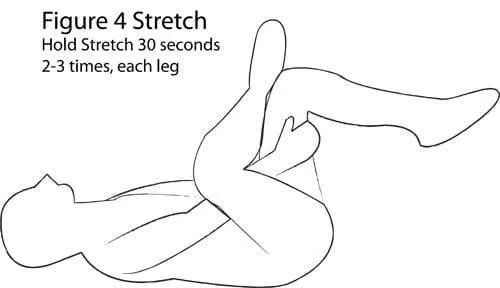
As you raise your legs towards the torso, cross your right foot over your left thigh.
Repetition on the opposite side follows a brief period of holding the position.
It’s crucial to avoid pushing this stretch. Instead, to achieve a deeper stretch, let gravity naturally draw your legs in closer to your body.
Knee to the opposite shoulder
Your gluteal and piriformis muscles can become inflamed and press against the sciatic nerve; this easy stretch helps release that pressure.
With your feet flexed upward and your legs extended, lie on your back.
Put your hands surround your right knee joint and bend it.
Pull your right leg in the direction of your left shoulder across your body. Keep it there for ½ minute. Always remember to only pull your knee as far as it is comfortable for you. Your muscles should stretch to release tension rather than hurt.
To keep your leg going back to where it was, push your knee joint.
After completing three repetitions, switch leg
Standing hamstring stretch
Sciatica-related hamstring muscle tightness and pain might be reduced with this stretch.
On an elevated surface, plant your right foot at or below hip level. This could be a step on a staircase, an ottoman, or a chair. To suppose that the leg and toes are straightened, flex your foot. Keep your knee slightly bent if it tends to hyperextend.
Your body should be slightly bent forward towards your foot. The stretch gets deeper the farther you travel. Avoid pushing yourself after the point of your pain limit.
Instead of lifting your raised leg higher, let go of its hip. To assist with lowering your hips, loop a long exercise band or yoga strap under your left foot and over your right thigh. Hold for 30 seconds.
After completing three repetitions, switch legs.
Standing piriformis stretch
Another stretching for sciatica pain is this one, which is done by you standing up. If you are able, you can do this without assistance, but it can be challenging to balance. As an alternative, you could also stand with your back to a wall and space your feet about 24 inches apart.
While standing up, place the leg that hurts over the knee of the other leg. With your hips lowered to the floor at a 45-
forty-five-degree angle, attempt to form the number four by bending your standing leg.
Maintaining a straightened back allows you to swing your arms and bend your waist of your body. Hold this posture of you for thirty to sixty seconds.
Repeat with your other leg.
Scissor hamstring stretch
The ischium, which is one of the components of the pelvic girdle along with the ilium and the pubis, is where the ischial tuberosity, also referred to as the sit or sit bones, starts.
The sacrotuberous ligament joins the hamstring muscles to the ischial tuberosity. A tight hamstring can resemble sciatica symptoms.
By releasing the tension in your hamstring muscles in the body, this stretch can help protect the sciatic nerve.
After your left foot by roughly three feet, place your right foot.

Your right hip shouldn’t protrude further forward than your left hip; instead, pull your hips forward and push your shoulders back. Using a mirror to assess this could be helpful.
Your hands should be on your hips. If you need aid balancing, you can use a chair or table.
Bend your waist slightly while maintaining a straightened back to slightly push your trunk over your front leg. Maintain your front leg’s weight of body.
After holding this posture for five to ten seconds, repeat the stretch with the other leg. Stretching each of the legs three to five times.
Forward pigeon pose
On all fours, kneel on the ground.
Raise your right leg of body and put it in front of your body on the ground. With your lower leg transverse to your body, it should be on the ground. While your right side of the knee stays to the right side, your right foot should be in front of your left knee.
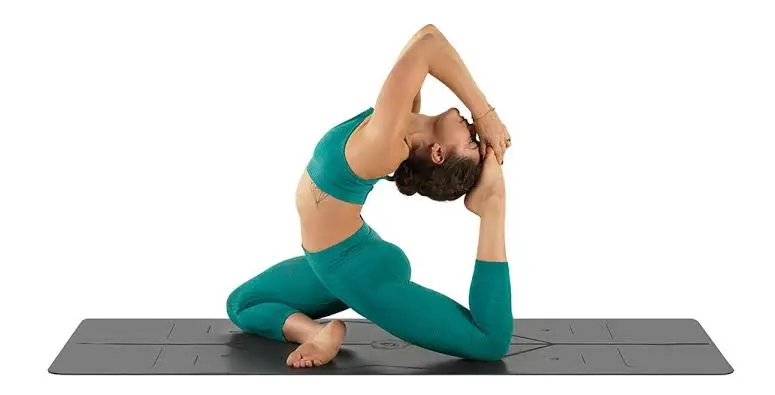
With the toes pointing back and the upside of the foot on the floor, extend your left leg fully behind you on the floor.
To suppose that your legs are supporting your weight, gradually transfer your body weight from your arms to them. Keep your hands on either side of your leg as you sit up straight.
Draw in a full breathing. As you push out the breath, bend your upper body forward over your front leg. As much as you can, use your arms to support your body weight.
Continue on the opposing side.
Summary
You might be able to find a successful treatment plan with the assistance of a doctor if you are experiencing new symptoms or if home remedies aren’t working for you. Your sciatic nerve may feel less pressure with the use of trigger point massage, physical therapy, and chiropractic adjustments. For those with sciatica, muscle relaxants, anticonvulsants, antidepressants, steroid injections, and surgeries have all shown therapeutic benefits.
It’s important to consult with a healthcare professional before starting any new treatment to ensure it aligns with your specific condition and medical history.
FAQs
Walking could help someone with sciatica manage their condition, but it’s crucial to avoid behaviors that could make the pain worse.
low back discomfort, alterations in the leg’s feeling
When symptoms first appear, they usually go away after six weeks.
Pain can be lessened and tissue healing can be accelerated with a mix of treatments, such as stretching following infrared radiation or topical medicine.
References
- Heitz, D. (2023, October 23). 9 stretches for sciatica pain relief. Healthline. https://www.healthline.com/health/back-pain/sciatic-stretches#forward-pigeon-pose
- Professional, C. C. M. (n.d.-d). Sciatica. Cleveland Clinic. https://my.clevelandclinic.org/health/diseases/12792-sciatica
- Barrell, A. (2021, February 4). What are the treatment options for sciatica pain? https://www.medicalnewstoday.com/articles/sciatica-pain-treatment
- Harvard Health. (2020, April 21). Sciatica home remedies and self-care. https://www.health.harvard.edu/pain/sciatica-home-remedies-and-self-care
- Martin, & Martin. (2022, October 8). 7 Tips for fast sciatic Pain Relief | Midwest Orthopedic Specialty Hospital. Midwest Orthopedic Specialty Hospital. https://www.mymosh.com/orthopedics/tips-for-sciatic-pain-relief/
- Vad, V., MD. (n.d.). 4 commonly overlooked sciatica remedies. Spine-health. https://www.spine-health.com/blog/4-commonly-overlooked-sciatica-remedies
- Team, C. (2020, February 6). Home remedies for sciatica. Colorado Pain Care. https://www.google.com/amp/s/coloradopaincare.com/home-remedies-for-sciatica/amp/

